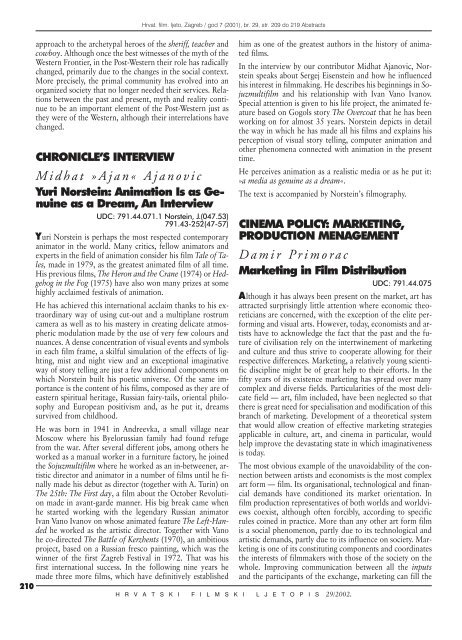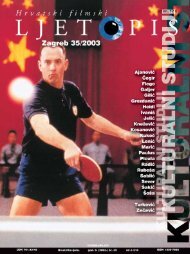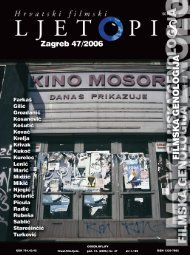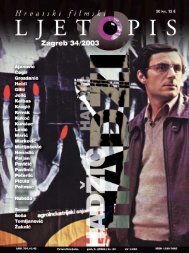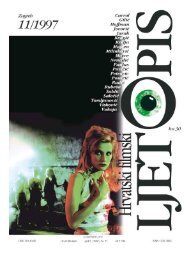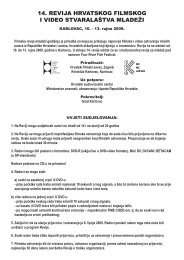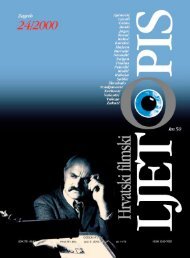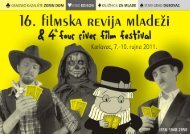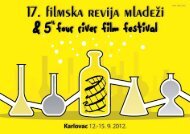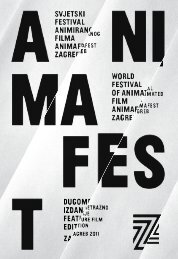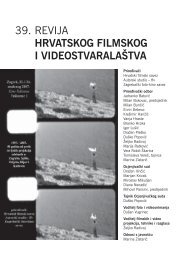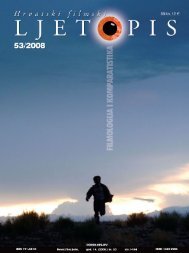Create successful ePaper yourself
Turn your PDF publications into a flip-book with our unique Google optimized e-Paper software.
approach to the archetypal heroes of the sheriff, teacher and<br />
cowboy. Although once the best witnesses of the myth of the<br />
Western Frontier, in the Post-Western their role has radically<br />
changed, primarily due to the changes in the social context.<br />
More precisely, the primal community has evolved into an<br />
organized society that no longer needed their services. Relations<br />
between the past and present, myth and reality continue<br />
to be an important element of the Post-Western just as<br />
they were of the Western, although their interrelations have<br />
changed.<br />
CHRONICLE’S INTERVIEW<br />
Midhat »Ajan« Ajanovic<br />
Yuri Norstein: Animation Is as Genuine<br />
as a Dream, An Interview<br />
UDC: 791.44.071.1 Norstein, J.(047.53)<br />
791.43-252(47-57)<br />
Yuri Norstein is perhaps the most respected contemporary<br />
animator in the world. Many critics, fellow animators and<br />
experts in the field of animation consider his film Tale of Tales,<br />
made in 1979, as the greatest animated film of all time.<br />
His previous films, The Heron and the Crane (1974) or Hedgehog<br />
in the Fog (1975) have also won many prizes at some<br />
highly acclaimed festivals of animation.<br />
He has achieved this international acclaim thanks to his extraordinary<br />
way of using cut-out and a multiplane rostrum<br />
camera as well as to his mastery in creating delicate atmospheric<br />
modulation made by the use of very few colours and<br />
nuances. A dense concentration of visual events and symbols<br />
in each film frame, a skilful simulation of the effects of lighting,<br />
mist and night view and an exceptional imaginative<br />
way of story telling are just a few additional components on<br />
which Norstein built his poetic universe. Of the same importance<br />
is the content of his films, composed as they are of<br />
eastern spiritual heritage, Russian fairy-tails, oriental philosophy<br />
and European positivism and, as he put it, dreams<br />
survived from childhood.<br />
He was born in 1941 in Andreevka, a small village near<br />
Moscow where his Byelorussian family had found refuge<br />
from the war. After several different jobs, among others he<br />
worked as a manual worker in a furniture factory, he joined<br />
the Sojuzmultifilm where he worked as an in-betweener, artistic<br />
director and animator in a number of films until he finally<br />
made his debut as director (together with A. Turin) on<br />
The 25th: The First day, a film about the October Revolution<br />
made in avant-garde manner. His big break came when<br />
he started working with the legendary Russian animator<br />
Ivan Vano Ivanov on whose animated feature The Left-Handed<br />
he worked as the artistic director. Together with Vano<br />
he co-directed The Battle of Kerzhents (1970), an ambitious<br />
project, based on a Russian fresco painting, which was the<br />
winner of the first <strong>Zagreb</strong> Festival in 1972. That was his<br />
first international success. In the following nine years he<br />
made three more films, which have definitively established<br />
210<br />
Hrvat. film. ljeto, <strong>Zagreb</strong> / god 7 (2001), br. <strong>29</strong>, str. 209 do 219 Abstracts<br />
him as one of the greatest authors in the history of animated<br />
films.<br />
In the interview by our contributor Midhat Ajanovic, Norstein<br />
speaks about Sergej Eisenstein and how he influenced<br />
his interest in filmmaking. He describes his beginnings in Sojuzmultifilm<br />
and his relationship with Ivan Vano Ivanov.<br />
Special attention is given to his life project, the animated feature<br />
based on Gogols story The Overcoat that he has been<br />
working on for almost 35 years. Norstein depicts in detail<br />
the way in which he has made all his films and explains his<br />
perception of visual story telling, computer animation and<br />
other phenomena connected with animation in the present<br />
time.<br />
He perceives animation as a realistic media or as he put it:<br />
»a media as genuine as a dream«.<br />
The text is accompanied by Norstein’s filmography.<br />
CINEMA POLICY: MARKETING,<br />
PRODUCTION MENAGEMENT<br />
Damir Primorac<br />
Marketing in Film Distribution<br />
UDC: 791.44.075<br />
Although it has always been present on the market, art has<br />
attracted surprisingly little attention where economic theoreticians<br />
are concerned, with the exception of the elite performing<br />
and visual arts. However, today, economists and artists<br />
have to acknowledge the fact that the past and the future<br />
of civilisation rely on the intertwinement of marketing<br />
and culture and thus strive to cooperate allowing for their<br />
respective differences. Marketing, a relatively young scientific<br />
discipline might be of great help to their efforts. In the<br />
fifty years of its existence marketing has spread over many<br />
complex and diverse fields. Particularities of the most delicate<br />
field — art, film included, have been neglected so that<br />
there is great need for specialisation and modification of this<br />
branch of marketing. Development of a theoretical system<br />
that would allow creation of effective marketing strategies<br />
applicable in culture, art, and cinema in particular, would<br />
help improve the devastating state in which imaginativeness<br />
is today.<br />
The most obvious example of the unavoidability of the connection<br />
between artists and economists is the most complex<br />
art form — film. Its organisational, technological and financial<br />
demands have conditioned its market orientation. In<br />
film production representatives of both worlds and worldviews<br />
coexist, although often forcibly, according to specific<br />
rules coined in practice. More than any other art form film<br />
is a social phenomenon, partly due to its technological and<br />
artistic demands, partly due to its influence on society. Marketing<br />
is one of its constituting components and coordinates<br />
the interests of filmmakers with those of the society on the<br />
whole. Improving communication between all the inputs<br />
and the participants of the exchange, marketing can fill the<br />
H R V A T S K I F I L M S K I L J E T O P I S <strong>29</strong>/<strong>2002</strong>.


